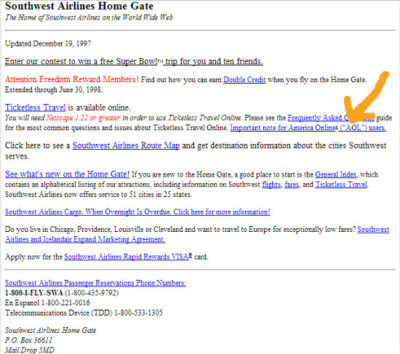What’s your usual shopping MO? For pretty much everything I buy other than clothes, mine goes like this: search Google Shopping for the product I want, then go search Amazon and check out the price there. If it’s less than 10% more expensive on Amazon, I usually go with that; otherwise, the cheapest price wins. (I also use some cashback sites like Ebates and Mr. Rebates, but we’ll leave those out of this discussion.) It used to be that Google was my one-stop shop, but in late 2012, Google started asking retailers to pay to be included in their Google Shopping search results. Amazon refused to pay, trusting in its popularity / size to attract customers anyway… and it worked. Today, when I’m really pressed for time, I might just shop on Amazon and call it a day.
Why is this the subject of a travel Thursday post? Well, I think this business strategy is an easy way to explain what Southwest has done with distribution. Back in the (mostly pre-internet) 90s, Southwest used to sell tickets through call centers and travel agencies. Travel agencies linked up to third party reservations systems, and there were four major reservations systems – but Southwest had to pay to distribute to each of them. Southwest chose to distribute only through Sabre, and the other reservation systems decided that they would carry Southwest’s inventory for free so that they wouldn’t be uncompetitive.
But in 1994, those other systems threatened to stop carrying Southwest schedules and fares. Rather than acquiesce to the pressure, Southwest chose to go the other direction: essentially pioneering ticketless travel. In 1995, they launched their “Home Gate” website (now also the name of one of their conference rooms at headquarters) to display fares and schedules, paired with a big advertising campaign reminding consumers that their tickets were only sold directly and not through third parties.

Today, savvy US airfare shoppers (hopefully you included?) know that when you search for flights, you have to take a two step approach: check ITA Matrix (or its more consumer-friendly acquirer, Google Flights), and then separately check Southwest.com. And enough people seem to be doing that (or perhaps just exclusively shopping on Southwest.com), because Southwest.com continually tops the rankings of US airlines for highest volume of web traffic. Like Amazon, their limited distribution strategy has proven quite successful, and may actually be driving extra traffic because people know they can’t take a one-stop shopping approach.
So, what’s going to happen now that Southwest launched a new reservation system this spring, which could make it easier to distribute tickets across online travel agencies (OTAs)? According to former CMO Kevin Krone, it doesn’t sound like changes will be happening anytime soon. But on the non-airline side, Amazon started buying new product listing ads with Google in December 2016… so it seems they may be shifting their strategy. We’ll have to wait and see if Southwest follows suit.

I no longer use Yelp for recommendations either.
Very interesting! My brother-in-law and sister-in-law both work for SWA (and so did my FIL until he passed away, I think he was there 30 years?). I have to admit, I exclusively fly SWA if I’m booking my own travel. Prices are great, customer service is great, I don’t care about having an assigned seat… what’s not to like?
Southwest is a fabulous airline!